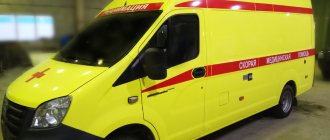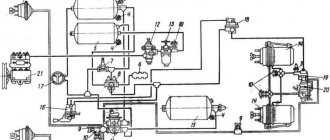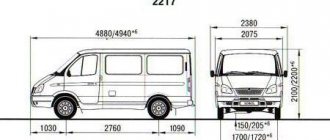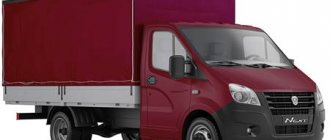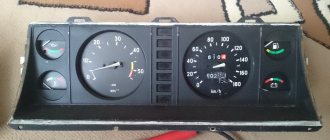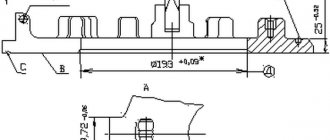Replaceable modular ASMP class C
One of the main new products presented at the exhibition is the GAZelle NEXT NN modular ambulance. A few days earlier, GAZ Group had already demonstrated the car to Mikhail Murashko, the Minister of Health of the Russian Federation. The show took place on August 1, 2022 during his visit to Nizhny Novgorod. Everyone liked the modular ambulance based on the GAZelle NEXT NN, and it was decided to test it in healthcare institutions of the Russian Federation.
The modular ASMP is a GAZelle NEXT chassis (A21R26), on which a special medical superstructure is installed. Unlike the traditional ambulance model, which is based on all-metal vans and minibuses, the modular design allows, if necessary, to easily remove the medical superstructure (module) and replace it with another superstructure for utility purposes (for example, a manufactured goods or insulated van). It is possible to install this medical module on another chassis. This approach to the production of ASMP is dictated by the epidemiological situation; it makes it easy to reduce or increase the fleet of medical vehicles, depending on the need. If the base chassis wears out as a result of intensive use, the module with expensive medical equipment can be completely transferred to a new chassis, which will significantly reduce the cost of updating the ambulance station fleet. The removable module has a strictly rectangular shape. It may be less aesthetically pleasing, but the lack of a narrowing at the top allows for more medical equipment to be placed. In addition, you need to remember about increasing the comfort of work for doctors while maintaining the overall compact dimensions of the car. The optimized shape of the module made it possible to maximally staff the emergency room and accommodate two patients in the cabin at once. I would like to remind you that class C implies the possibility of carrying out emergency medical treatment by the resuscitation team, as well as transporting and monitoring the patient’s condition at the prehospital stage.
Production of an ambulance based on GAZelle
It’s no secret that the most popular and widespread ambulances are those on the good old GAZelle chassis. The reasons for this popularity are the simplest: more favorable prices than for foreign cars, and adaptability to work on Russian roads. In fact, no matter how “native Russian” GAZelle is, it is able to easily overcome a road with bumps and potholes and at the same time quickly arrive at the place of call.
Types of ambulance GAZelle
A person, seeing a vehicle, determines by all its external signs that there is an ambulance in front of him. In fact, it is divided into three classes depending on its purpose, which we offer to our customers:
- Class A - used by line services;
- Class B - used for intensive care;
- Class C - is a resuscitation vehicle for providing resuscitation measures.
Accordingly, the price for them increases depending on the total cost of the equipment installed in the medical staff salon. In addition, the final cost of the conversion also includes the characteristics of the technical equipment of the chassis, including the drive, engine and its cost.
Our company receives many requests from private clinics who want to convert GAZ into ambulances due to their interest in having their own fleet of special vehicles. In this case, we have a custom car manufacturing service. Based on the customer’s requests, a layout of the salon is established, how it will be equipped and with what medical equipment.
You can go into long discussions about what is preferable to buy - a GAZelle ambulance or an ASMP based on foreign cars, but nothing can refute the fact that it was our vehicles that saved many people and that they are reliable and practically trouble-free in operation.
It is possible to manufacture a car to order with the equipment you need, interior design and medical equipment.
Class C ASMP based on a bus
Another very expressive new product was an ambulance based on the GAZelle NEXT bus (A64R45). Its main feature is that it is made on the basis of a full-fledged Citiline frame bus, and not on the basis of an all-metal van. The result was not only a convenient layout for transporting patients over long distances, but also a very aesthetic appearance. The increased size of the interior of this medical vehicle immediately caught my eye. This space allows you to organize a transformable workspace in the car with comfortable swivel chairs for medical workers, ensure convenience of working with the patient and safe placement of personnel while driving.
The outer cladding of the machine is made of high-strength fiberglass reinforced plastic. The interior is also made of attractive looking fiberglass. It should be noted that the plant began to pay a lot of attention to the aesthetic side. In addition, the materials from which the car is made are practically not subject to wear and aging and retain their original appearance for the entire service life. Due to the small number of joints, they allow easy cleaning and disinfection.
Domestic cars in the service of the Moscow ambulance
The role of ambulance transport during emergency medical services is extremely high. Because in order to professionally and promptly provide medical care, it is necessary to deliver an ambulance to the patient. And in case of emergency indications, evacuate the patient to a specialized hospital.
This can only be done with special vehicles. Moreover, the specific nature of the work places special demands on the ambulance.
For Motorist Day, we decided to talk about the history of the emergence and development of ambulance transport in the Moscow ambulance service, focusing on domestic ambulances and emergency medical services.
In the first years of its existence, the Emergency Medical Service Station had exclusively foreign-made vehicles. They were all worn out. In 1925, five Mercedes 15/70/100 PS (Tour 400) ambulances were purchased, a year later three more, then Renault and Fiat ambulances. In 1925 -1929. 2-3 cars were on duty at the Station around the clock. Each year, each of them made an average of 3.5-4 thousand trips. By the 1930s, the Station gradually switched to cars of domestic brands: AMO, GAZ-A, GAZ-AA, ZIS-101.
An increase in calls and an increase in the number of substations required an appropriate fleet of vehicles - fast, roomy and comfortable, however, ambulances in the USSR, which were built mainly on imported chassis, as well as on the domestic AMO-F-15 chassis, did not fully meet the requirements, mainly which was to reduce shaking and suffering of transported patients.
A truck with a rigid spring suspension is not the best solution for ambulances, but back then they were happy with that. The first ambulance on the AMO-F-15 chassis was built by the body shop at the Moscow plant AMO (Automobile Moscow Society) in 1925. In 1926, the plant assembled four such ambulances, and in subsequent years they produced from six to eight vehicles, that is, their serial production was being established. In 1928, the Moscow Health Department already had 20 AMO ambulances. In addition, such cars were supplied to provinces neighboring Moscow, for example, Ivano-Voznesensk, where they were also used. In total, about three dozen AMO-F-15 ambulances were built.
The ambulance vehicle based on the AMO-F-15 had an open driver's cabin, over which hung a rigid canopy (in bad weather, canvas curtains were pulled over its sides), and a closed bus-type ambulance body with a wide double-leaf rear door for loading stretchers. Two stretchers were placed in the body, one above the other, on the left side (in the direction of travel), and a small bench was attached to the right, on which accompanying persons could sit. The car body was not heated during the cold season, but for ventilation, a special “mushroom” type device was provided in the roof of the car, providing air exchange. Ambulances, unlike trucks, had “solid” steps that covered the sides of the frame and the space between the wheels, as was done on passenger cars. The identification marks of the ambulance were red crosses inscribed in a white circle, which were applied to the windshield of the cab, the sides of the body and the rear doors. Some cars were additionally equipped with a headlight with frosted glass (on the roof in front or on the side wall of the body) and the red cross emblem. The cars were marked with an inscription indicating that they belonged to the Moszdravtdel, as well as telephone numbers through which it was possible to organize the transportation of sick and injured people. There were no special standards for the painting of ambulances at that time, so they were painted differently in different cities. Only in the second half of the 30s was a single color adopted for civilian ambulances - cream, which was assigned to such vehicles for many years, and only in the 70s of the last century did the standard familiar to us today appear - a white car with wide red stripes.
However, the design of the car caused fair criticism among drivers, as well as doctors and paramedics. The very rigid “cargo” suspension made the carriage shake, and therefore unsuitable for transporting patients. The car depot masters tried to replace the AMO springs with longer and thinner ones and change their attachment points, but this did not solve the problem of adapting the “brutal” truck to the needs of medicine. The car is shaking (the truck had very stiff springs), with a very uncomfortable driver's seat, an outdated design by that time, not very reliable due to the low quality (semi-handicraft) components and inept assembly, and very expensive - clearly not the most convenient for ambulance service . As a result, the AMO-F-15 did not quite “fit” into the requirements of the Moscow Ambulance Station, but there was no other serial domestic chassis in those years.
For a long time, there were no specialized factories in the country that produced ambulances, so in the 1920s - 1930s, ambulance depots were forced to make the necessary rolling stock on their own, using standard truck chassis, on which simple wooden bodies were installed, suitable for placing stretchers. These cars had neither factory nor production designations. It was only in the mid-1930s that the situation with ambulance transport began to change.
The Gorky Automobile Plant (GAZ) became the first domestic enterprise to establish mass production of cars and trucks, which were widely used both in the Red Army and in the national economy. The basis for future Soviet GAZ cars was the cars of the American concern Ford Motor Co. – a middle-class passenger car “Ford-A” with an open 5-seater 4-door phaeton-type body and a 1.5-ton Ford-AA truck. A licensed copy of the Ford-A car, equipment and documentation for its production were purchased by the Soviet Government in the USA in 1929 from Ford Motor Co. During the construction of GAZ, these cars were initially assembled at the Moscow KIM plant and the Nizhny Novgorod "Gudok Oktyabrya" plant. Produced since December 1932, the GAZ-A passenger car, on a rear-wheel drive chassis (4x2) with a front-mounted 40 hp engine, immediately entered service with the Red Army as a command vehicle. Along with the GAZ-A passenger car, the Red Army also used GAZ-4 pickups built on its chassis and several types of ambulances (ambulance vehicles) with a carrying capacity of 500 kg. The GAZ-A car and its variants were produced from 1932 to 1936 at the Gorky Automobile Plant, and from 1933 to 1935, in addition, at the KIM plant (Moscow). A total of 41,917 GAZ-A vehicles were produced in all modifications, of which 10,500 were GAZ-4 pickups and ambulances.
The ambulance ambulance on a GAZ-A chassis had a vehicle frame structure - the frame consisted of two spars connected by transverse beams. The vehicle received a double cabin from a GAZ-AA truck for the delivery of medical personnel. The closed "van" body was a wooden frame, lined on the outside with sheet steel and lined with plywood on the inside, with double doors mounted in the rear wall. The “sanitary compartment” was separated from the driver’s cabin by a partition. Inside the body, two lying wounded people could be placed on stretchers or five seated patients - on folding seats hinged to the walls of the body.
The engine is a four-stroke 4-cylinder carburetor liquid-cooled GAZ-A, with a power of 40 hp. allowed the car to move on the highway at a maximum speed of 50 km/h. With a full tank of fuel (capacity 40 l), the car could travel 200 km. The car bumper is made of two elastic steel strips. The radiator is decorated with the first emblem of the Gorky plant - a black oval with the letters “GAZ”. The front fenders are made using deep stamping. Clutch – single disc, dry. The gearbox is three-speed, three forward speeds and one reverse. The main gear to the rear axle was a pair of bevel gears with spiral teeth. The suspension of both the front and rear axles is dependent, on transverse springs, with 4 single-acting rotary-type hydraulic shock absorbers. Shoe brakes, with mechanical drive. The parking brake is a band brake on the rear axle. Tires – 5.50-16 inches, wheels – metal. Civilian ambulances, as a rule, were painted in white, gray and sand colors, and vehicles intended for the Red Army were painted in protective colors. Their belonging to ambulance transport was revealed only by the obligatory lamp with a red cross above the driver’s windshield. During trips, it was supposed to be turned on so that passers-by and oncoming drivers could identify a medical vehicle in the stream and give it the right of way. In civilian cars, the Red Cross emblem was often additionally applied to the sides of the body (mainly on the windows). In the “military version” this was rarely practiced, and if crosses were applied, they were small in size. During the war, for safety reasons, they tried not to distinguish ambulance transport from other equipment.
On the basis of the GAZ-A car (according to other sources GAZ-AA), in 1936 a specialized vehicle with the symbol SP-36 was designed and built (see photo). It had two swing doors at the back. It is not known exactly how many of these machines were produced.
The SP-36 ambulance was built as a prototype by the workshops of the Mosgorzdravtdel motor depot in Moscow (director P.N. Rodionov) on a modified GAZ-AA chassis. The SP index - 36 was assigned to the vehicle conditionally, since the design was nameless. The suspension of all wheels is on four longitudinal springs with shock absorbers, the rear wheels are single-pitch, which was the difference between the SP-36 chassis and the GAZ-AA. The streamlined body with seating for seven (including stretchers for patients) was a wooden frame with metal sheathing. The patient compartment is fenced off from the driver's seat. The vehicle's equipment included a siren-type signal and an identification light with a red cross.
Year of construction SP - 36 (Ambulance) - 1936; number of places - 7; engine: type - four-stroke, carburetor, number of cylinders - 4, displacement - 3285 cm3, compression ratio - 4.6, power - 50 hp. With. / 37 kW at 2800 rpm; number of gears - 4; main gear - bevel gears; tire size - 6.50-20 inches: length - about 5500 mm; width - 2340 mm; height - 2100 mm; base - 3340 mm; track 1405 mm: curb weight - about 2400 kg; highest speed - 70 km/h.
The most widespread ambulances were based on the GAZ-AA cargo truck. GAZ-AA/MM is a Soviet truck manufactured by Nizhny Novgorod (in 1932), later Gorky Automobile Plant, with a payload of 1.5 tons, known as a lorry. The model was an American Ford model AA truck from 1930, but was subsequently redesigned according to domestic drawings.
Structurally, the GAZ-AA truck was made according to the classical design on a frame chassis with spring suspension. The cabin plumage is unified with the GAZ-A passenger car. A special feature of the design was the design of the rear suspension and transmission, where the so-called pusher pipe was used as a longitudinal rod, inside of which there was a closed cardinal shaft, which rested on a bronze bushing, subject to rapid wear and the need for frequent repairs. The fastening of the reaction rod of the front suspension, which absorbed the force during braking, also had insufficient survivability.
Thanks to mass conveyor production, the GAZ-AA/MM was the most popular truck, and indeed a car in general, in the pre-war USSR. Its chassis served as the basis for the creation of a number of specialized and special modifications for military and civilian purposes, including ambulances (in the photo there is an ambulance from the Moscow Gorevakopunkt).
When developing a new mass-produced universal ambulance that could be used in both civilian and military medical institutions, the designers took the American Ford ambulance (police) car of the 1930-1931 model. In 1935, the first prototype was built, which later underwent some simplification, in particular, the body lost the light on the roof. The modified model was assigned to be produced by the bus workshop, which is part of the automobile plant named after. Molotov (the former First Automobile Assembly Plant and the future Gorky Bus Plant), which was located in close proximity to the automobile plant itself. The Kazan Body Plant was chosen as a backup plant. By 1938, the new car was ready and received the GAZ-55 index. The official name of the “nurse” is GAZ-55-55, where the first number indicated the chassis model, and the second – the body model. Since both of these numbers coincided with the GAZ-55-55, the second number was very often omitted. Sometimes the car was called M-55 (“Molotovets-55”) in documents.
An unusual chassis was used for the ambulance (as can be seen from the index). It differed from the standard GAZ-AA by a modified suspension with extended rear springs and six lever hydraulic shock absorbers from the GAZ-M1 (two at the front and four at the rear). With such a suspension, the ride of the vehicle became much softer, which was important when transporting the sick and wounded. Inside the car it was possible to transport either four people lying on stretchers and two sitting on folding seats, or two on hanging stretchers and five on folding seats. Changes were also made to the exhaust system, since the medical compartment was heated using exhaust gases passing through two heaters installed on the floor, under the benches.
At various times, a standard GAZ-AA engine with a power of 40 hp could be installed on the GAZ-55 chassis. With. or more powerful GAZ-MM (50 hp). The closed body was a wooden frame, lined on the outside with sheet steel and lined with plywood on the inside. The “sanitary compartment” was separated from the driver’s cabin by a partition. The body was equipped with stretchers in three tiers (the upper stretchers were attached to folding supports on the ceiling). In the cabin of the "nurse", depending on the circumstances, either four people were placed on hammock stretchers and two on folding benches, or two on suspended stretchers and five on seats, or eight only on folding benches. In addition to heating, the sanitary body was equipped with active ventilation - three fans were mounted in the roof, two blowers and one exhaust.
Mass production of the GAZ-55 began in 1938. During the first year of mass production, 359 copies of the GAZ-55 were produced, another 72 chassis were sent to the Kazan Body Plant. In subsequent years, the production of sanitary vans increased in speed. In 1939, two factories already produced 1,293 cars, and in 1940 - 1,429 units (in the photo of A. Rodchenko, an ambulance on Myasnitskaya Street, 1930s).
During wartime, the GAZ-55 was produced only in Gorky, and ambulance bodies began to be installed on conventional chassis without modified suspension. In 1942, the design of the car was significantly simplified: stamped wings were replaced by bent, L-shaped ones; the cars lost one headlight, front brakes, glazed body and much more. However, from 1943 the plant practically returned to the pre-war design, with only the bent fenders giving away the time of production of the vans.
“Nurses” GAZ-55, which became the main “linear” transport of ambulance stations throughout the country, were produced at the Gorky Bus Plant until 1950. During this time, 12,044 ambulance GAZ-55s were assembled in Gorky alone. Civilian ambulances, as a rule, were painted in white, gray and sand colors, while vehicles intended for the army were painted in classic protective colors. Their belonging to ambulance transport was revealed only by the obligatory lamp with a red cross above the driver’s windshield.
During the Great Patriotic War, the USSR gained experience in operating and servicing a wide variety of foreign automotive equipment: captured German and American received under Lend-Lease. This allowed Soviet designers to get acquainted with the latest achievements of recognized leaders in the automotive industry using full-scale specimens. To compensate for the time lost due to the war and the general lack of experience, Gorky's designers took advantage of the information obtained in this case - in particular, they borrowed the general design plan of the front suspension, as well as many elements of the sub-engine frame and the power elements of the bottom, which had a modern monocoque body and close to The car being designed at GAZ has the mass and dimensional characteristics of the German Opel Kapitan model of 1938.
As soon as a top-class domestic car appeared in the USSR, they tried to adapt it for transporting patients. In 1939, at the plant named after. Likhachev built two prototype ambulances based on the ZIS-101. The Soviet limousine ZiS-101 became an excellent basis for creating an ambulance due to its speed and soft suspension.
The medical modification was created at the plant according to the design of I.F. German with the active assistance of the heads of the Ambulance Station A.S. Puchkov and A.M. Nechaev. Externally, in addition to the light color, corresponding inscriptions on the body and a lamp with a red cross on the roof, the cars differed from ordinary ZISs in the absence of a luggage grill at the rear, which was done to simplify access to the standard opening in the rear wall of the body, through which stretchers with patients were brought into the cabin . Despite the size of the car, loading through the hatch was not very convenient due to its small size; for example, loading pregnant women in this way was prohibited precisely because of restrictions on the height of the opening. These machines worked in the Moscow ambulance in the post-war period, as well as in other large cities with an equipped road network.
On the same basis of ZIS-101A vehicles, which had undergone major overhauls, the Moscow plant Aremkuz built AKZ-4 ambulances in small quantities in the late 1940s.
But the sanitary version based on the ZIS-110 was immediately included in the range of passenger cars planned for production. Compared to the limousine, the sanitary version had a number of serious differences.
Technical specifications:
| Wheel formula | 4 x 2 |
| Passenger capacity, persons | 4 + 1 on a stretcher |
| Engine | ZIS-110, petrol, eight-cylinder, in-line |
| Power | 140 hp, at 3,600 rpm |
| Working volume, l | 6,005 |
| Transmission | Mechanical, three-stage |
| Maximum speed, km/h | 140 |
A partition inside the body (of a slightly different type than a limousine, with sliding glass) divided the internal space into two independent compartments - the driver’s cabin and the medical salon. In the medical salon, a stretcher with a sick or injured person was placed and fixed on special guides, and two folding seats were installed for accompanying personnel.
To make it easier to load the stretcher into the cabin, the designers redesigned the rear part of the car. And although it retained the same body contours as the base limousine, instead of the trunk lid and rear window, a large lifting fifth door was installed on the “nurse,” which actually turned this car into a station wagon. For hygienic reasons, the compartment for the car's spare wheel, located under the floor of the medical salon, was made completely insulated. A special folding hatch, located under the fifth door, led to it. Ambulances were, as a rule, light beige in color, and the windows of the medical compartment were frosted, opaque, or covered with curtains. As an identification mark of the ambulance, an additional headlight with the symbols of the red cross was installed above the windshield of the vehicle.
ZIS-110 ambulances were used mainly in large cities, where their main advantages in speed and comfort over other ambulances could be fully used. In addition, these cars were very sensitive to the quality of gasoline and its octane number - at first, a special grade of “Extra” gasoline was even specially produced for ZIS-110 passenger cars. In total, at least 2089 copies of all modifications were manufactured on the basis of the ZIS-110, including 48 ambulances (of course, this was negligible for our country). Today, these machines are often designated by the index ZIS‑110A, or ZIL-110.
The first in the line of specialized vehicles used for emergency medical care was the Moskvich - 400-420M. The professional orientation of these ordinary-looking passenger cars was expressed in the application of red crosses in a white circle on the windows and simpler and cheaper interior trim.
As a rule, such cars had derated engines capable of running on low-octane gasoline. It is interesting that the Moskvich-407M included a first aid kit, which is mandatory for all cars today, as professional equipment.
GAZ-12B ZIM - sanitary version, produced from 1951 to 1960. The cars were painted in a light beige color; in addition, they differed in appearance from a regular sedan by the external hinges of the trunk lid, which opened to a large angle and allowed a stretcher to be rolled into the car interior. The ambulance had a glass partition behind the front seats, two folding chairs and a retractable stretcher in the rear compartment. In addition, the cars were equipped with a top light with a red cross and a searchlight on the driver's side.
The front two seats were separated from the rest of the cabin by a glass partition. The body remained a 4-door, the stretcher was loaded and unloaded through the trunk lid. GAZ-12B had an identification lamp on the roof and a searchlight on the left front fender. Such vehicles remained in service until the early 80s. In the same 1951, 3 copies were produced with a 4-door open phaeton body - GAZ-12A. The car did not go into production; the strengthening of the body, associated with the “removal” of the roof, resulted in the car being too heavy for a 95-horsepower engine, and its dynamic performance turned out to be unsatisfactory.
"Pobeda" is a Soviet middle-class passenger car, mass-produced at the Gorky Automobile Plant in 1946-1958. The factory model index is M-20. Belongs to the third generation of GAZ passenger cars, is the “successor” of the M-1 model. Serial production of Pobeda cars began on June 28, 1946. A total of 241,497 cars were produced until May 31, 1958, including 14,222 convertibles and 37,492 taxis. "Pobeda", along with Moskvich-400-42M, was actively used to transport medical personnel and to serve patients at home. Such cars were no different in appearance from the serial ones, except for the corresponding body color and headlights with a red cross on the roof. Due to the lack of transport for transporting patients to medical institutions, one of the motor depots subordinate to the Ministry of Health, an attempt was made to create similar transportation on the Pobeda base.
The modification affected mainly the interior of the car. The rear sofa was divided into two parts: the right, which was not much different from the usual Pobeda seat, and the left, which was a compact hard seat with a folding back. In the folded position, the backrest was flush with the wooden flooring on the floor of the trunk, and then a stretcher with a patient could be rolled onto the resulting platform. The stretchers were equipped with wheels; in the stowed position they were folded in half and placed in the trunk.
To accommodate the stretcher, we had to abandon the shelf in the trunk and place the spare wheel vertically. The gas tank was slightly modified for this purpose, because with the standard wheel and gas tank standing vertically, the wheel did not fit into the trunk. The length of the stretcher (180 cm) made it possible to transport even quite large patients, but the doctor’s access to the patient was inconvenient: if the upper part of the patient was accessible to the doctor, since he was located nearby, then to manipulate the legs he had to squeeze into the trunk.
Externally, the ambulances were distinguished by their coloring (white or beige), the red cross identification mark, the inscription on the sides and the red cross logo on the roof. Medical equipment was not installed on a regular basis - it was assumed that the doctor would take care of everything necessary. Perhaps a batch of similar machines was produced. They were also used in the Moscow ambulance. But they did not go for a long time and soon gave way to the medical GAZ-12B. Mainly due to the fact that Pobeda, like any passenger car, is too small for a stretcher with a patient, a doctor, a paramedic, an orderly, a driver, medical devices and instruments.
In connection with the upcoming removal from the assembly line of the large class model GAZ-12 (ZIM), a version of which was used as an ambulance, the Automobile Ministry instead needed to create a similar car based on the middle class model, as it was easier to operate, economical and cheaper compared to the GAZ-13, which is replacing the ZIM Chaika. To justify the minimum economically feasible scale of production, it was also envisaged to create a cargo-passenger version based on the ambulance for trade organizations. Experimental and pre-production prototypes were built on the basis of the “second series” GAZ-21I, but mass production began only in 1962, after the transition to the “third series”.
"Volga" GAZ-22 is the first domestic station wagon suitable for medical service, including the provision of ambulance and emergency medical care. Before it, patients were transported mainly in “carriages” built on the basis of trucks, in a few ambulance ZIS and GAZ-12 ZIM. Local doctors went on calls in ordinary Muscovites, where, naturally, the patient could not be admitted. The Moskvich-423 station wagon was a bit small, but the Volga was just right.
Production of the Volga ambulance GAZ-22B began in 1962. The car was equipped with a 75-horsepower 2.5-liter engine and a three-speed gearbox. Since 1965, the main medical model was called GAZ-22D. The long list of modifications also included export versions with 80- and 85-horsepower engines. Production ceased in 1970. The car was quite strong and durable, and maintenance and repair, although labor-intensive, were not difficult even for the least qualified mechanic. Sanitary modifications of the GAZ-22 had a mount for a stretcher in the back and minimal medical equipment. There was a partition in the cabin after the front seat. The salon was heated and had good lighting. Externally, ambulances were distinguished by identification marks (red crosses), frosted rear windows, a searchlight (spotlight) on the left front fender and an identification red cross on the roof. Painted white. The car could carry a bedridden patient and two accompanying persons sitting next to him. This model was replaced by a similar car GAZ-24-03, created on the basis of the GAZ-24-02 station wagon.
At the Gorky Automobile Plant, ambulances on the Volga chassis were produced since 1962, when the GAZ-22B model appeared, and then, as each new Volga model appeared (except perhaps 3102), it had a medical modification, the last sanitary " Volga" was GAZ-310231, which was produced until 2008. Such cars were no longer used as “ambulances”, and were intended simply for transporting patients; for this purpose, stretchers and seats for accompanying persons were placed in the cabin (the layout of the cabin has remained virtually unchanged since the days of the GAZ-2403).
UAZ and RAF minibuses, including the sanitary version, appeared in the country almost simultaneously. Such machines were very necessary. Indeed, until the end of the 1950s, the main ambulance was the PAZ-653 - a booth on the chassis of the GAZ-51 truck, as well as the GAZ-12 ZIM and ZIS-110. The car on a truck chassis was spacious, however, very shaking. ZIS and ZIM walked smoothly, but it was cramped for doctors and paramedics: you can transport a patient, but you can’t provide serious assistance along the way, and you can’t accommodate the necessary equipment. In addition, the cost of a “nurse” based on a large expensive sedan, especially a government small-scale limousine, was high. UAZ was made primarily for rural areas and at first in small quantities. So the RAF became the main city vehicle for hospitalizing patients. Since the 1960s, the main enterprise in the USSR supplying the country with emergency medical vehicles has been the Riga Bus Factory.
RAF-977 “Latvia” is a series of minibuses produced by the factory in 1959 - 1976 on the units of the GAZ-21 Volga car. RAF minibuses were used, among other things, as ambulances until the end of the 70s, after which the bulk were replaced by RAF-2203 minibuses. Track record: the first experimental ambulances were built on the basis of the 1958 RAF-977 model. The serial RAF-977I has been produced since 1962. The modernized RAF-977IM has been produced since 1968. It had GAZ-21 units, including a 2.45-liter engine (75 hp) and a three-speed gearbox. The set of medical equipment depended on the location of the machine. Production continued until 1976 - until the moment when they switched to RAF-2203 and sanitary RAF-22031.
RAF-2203 “Latvia” - Soviet minibuses, mass-produced at the RAF minibus plant in Jelgava in 1976-1997. Cars of this model were widely used as official transport, ambulances and minibuses until the 2000s, then they were replaced by Gazelles.
The main differences between the car were the completely redesigned body and main components from the more modern Volga GAZ-24. As a result, the new model became noticeably safer and more comfortable than its predecessor RAF-977: the proportions of the body changed, the center of gravity decreased, which, coupled with a successful choice of suspension elements, made the car is more stable and maneuverable, although problems with weight distribution along the axles remain.
In 1979-1987 On the basis of the RAF-2203 with a high fiberglass roof, a resuscitation vehicle was produced, assembled and equipped (Finland). Produced in small batches.
Nobody knows how many lives such RAFs saved. After all, they worked diligently in all corners of the Soviet Union, in big and small cities, including on the Moscow ambulance. Of course, machines that worked day and night almost without interruption required constant attention. Parts of the Volgov suspension and steering were worn out, and the supporting body was not the strongest and most durable. However, individual machines served until the 1990s.
UAZ-2206/3741/3909/39094/3962/3303 (colloquially - “Loaf”) is a family of Soviet and Russian all-wheel drive light-duty cargo and passenger off-road vehicles produced at the Ulyanovsk Automobile Plant. Serial production of the UAZ-452 (sanitary) began in 1965.
The car could accommodate up to four stretchers or eight on benches and one attendant in both cases. There are up to 11 seats in total. The vehicle did not provide comfort when moving, the suspension remained with the standard model, but was the only ambulance capable of reaching the most remote places. A reliable, simple and trouble-free car is still produced to this day.
GAZ-32214 is a specialized sanitary and medical vehicle, intended for use at ambulance stations and other organizations providing medical services. It was created on the basis of the GAZ-2705 van and differs from it externally only in its coloring, made within the framework of the color scheme according to GOST R50574-2002, and the presence of flashing lights.
The length of the medical van is 5540 mm, the wheelbase of the GAZ-32214 is 2900 mm, the front and rear overhangs are 1030 and 1610 mm, respectively, the width of the van does not exceed 2075 mm, and the height is limited to 2480 mm. The car is equipped with a side sliding door on the right side, as well as a rear hinged double door for convenient loading of stretchers with patients. The curb weight of the GAZ-32214 does not exceed 2870 kg. The total weight of the van is 3500 kg. The all-metal cabin of the GAZ-32214 has a three-seat passenger compartment, separated from the medical compartment by a metal partition with a sliding window. The medical salon is equipped with three seats, while the right seat has a reclining backrest for installing additional stretchers. Among other equipment, it is necessary to note the presence of a receiving device for a stretcher, a side step (modifications 322174-408 and 322174-410), as well as a washbasin with an electric water supply pump and built-in tanks. In addition, modifications 322140-410, 322174-408 and 322174-410 received a high roof, making it easier to provide medical care directly inside the car.
All modifications of the GAZ-32214 are equipped with gasoline 4-cylinder in-line engines with a distributed fuel injection system. Depending on the version, the van is equipped with either a 2.45-liter ZMZ-402 unit with an output of 100 hp. at 4500 rpm and a torque of 183 Nm at 2400 - 2600 rpm, or a 2.46-liter ZMZ-40524 engine, the power of which reaches 133 hp. at 4500 rpm, and peak torque occurs at 214 Nm at 4000 rpm. Both engines are paired with a non-alternative 5-speed manual transmission equipped with a single-plate dry clutch with a hydraulic drive. The frame structure of the GAZ-32214 medical van chassis is supported by dependent leaf spring suspension at the front and rear. The front axle wheels are equipped with disc brakes, while the rear wheels use simple drum brakes. The car is equipped with an ABS system. The wheel arrangement of the GAZ-32214 is 4x2 with rear wheel drive. GAZ-32214 is capable of accelerating to 115 km/h maximum speed on paved roads. All modifications of the van are equipped with power steering, a GAZ 32214-32 heater and a medical cabin ventilation system.
Currently, the Emergency and Emergency Medical Care Station named after. A.S. Puchkova is equipped with motor transport based on Mercedes, Ford, Gazelle cars, which are equipped with modern equipment, which makes it possible to provide high-quality emergency medical care to residents of the capital.
Since state ambulances were sent to a landfill after being written off, most of the “living” vehicles that we described in our article were almost not preserved. We hope that the proposed material, accompanied by photo illustrations, will fill this gap in the glorious history of the Emergency Medical Care Station named after. A.S. Puchkova.
Sources:
1. Puchkov A.S. Organization of emergency medical care in Moscow. Chapter IX Station equipment. P.163-168. Medgiz, 1947.
2. Shugurov L. M. Cars of Russia and the USSR. - M.: ILBI, 1994.
3. Vakhrameev A.V. Moscow ambulance. P.62.1994.
4. Car in service, issue No. 32, 2012.
Mobile medical center
A mobile medical complex was also made on the basis of the GAZelle NEXT bus (A63R45). It can be used for mass on-site vaccinations, medical examinations, on-site diagnostics and other medical events. It is possible to attach an additional trailer module, which will house a second medical room. In addition to medical equipment and furniture, the vehicle is equipped with autonomous life support systems, a generator and a built-in bathroom.
Mobile medical office
Based on the GAZelle NEXT 4.6 with an extra-long wheelbase (A31R33), the Health Cabinet was shown. Such a machine directly meets the needs of ensuring equal access to medical care for all Russian citizens, regardless of their place of residence. This is a very effective tool in the current social and economic conditions of Russia. A mobile medical office is perfect for on-site diagnostics, screening people’s health status, identifying risk factors, mass medical examinations at enterprises and small towns, as well as for accompanying crowded public events. The increased wheelbase and long body length allow you to place two medical rooms in one car. For example, one can be allocated for therapeutic appointments, the other for special examinations.
Ambulance vehicle specification class B
1. Basic chassis 1.1 Gazelle next, white body 2.1 Interior dimensions (length/height/width), 616 x 175 x 275 cm.
3. Medical salon floor 3.1 Floor covering is waterproof, antistatic, anti-slip, resistant to cleaning disinfectants 3.2 Border along the bottom of the side panels made of polished stainless steel 3.3 Waterproofing of seams in the color of the floor covering
4. Partition 4.1 Partition between the cabin and the salon with a sliding frosted window 4.2 Loading space in the upper part of the partition (equipped with a door and a gas elevator and an individual lamp)
5. Glazing of the medical salon 5.1 Glazing of the rear doors 5.2 Glazing of the side door of the salon with a sliding window 5.3 Frosting of 2/3 of the height of the glass of the salon doors
6. Handrails, handrails 6.1 Sliding door handrail made of thick-walled stainless steel 1 pc. 6.2 Rear door handrail made of thick-walled stainless steel 1 pc. 6.3 The ceiling handrail is made of stainless thick-walled steel along the receiving device with two brackets for the infusion system, equipped with two bag holders and two holders of cylindrical containers 1 pc.
7. Steps, steps 7.1 Rear door step (not installed if included in the base) 7.2 Side door step
8. Heating, ventilation and air conditioning 8.1 Glass ceiling hatch 530x820 mm, used as an emergency exit (installed with ceiling reinforcement) 1 pc. 8.2 Ceiling supply and exhaust two-speed fan (activated by wall key) 1 pc. 8.3 Autonomous air heater 4.0 kW is located in the area of the rack for mounting medical equipment on the left side (control is carried out by a wall-mounted temperature controller near the sliding door) The heater is equipped with a diagnostic system with information about detected faults displayed on the control unit 1 pc. 8.4 Parking electric heater 220V is located under the right seat (controlled by a wall-mounted temperature regulator near the sliding door) 1 pc. 8.5 The air conditioner evaporator of at least 3.7 kW in the medical salon, if there is an air conditioner in the base, is located on the partition
9. Personal disinfection device 9.1 Hand disinfection dispenser 9.2 Towel holder for paper towels 9.3 Container for used paper towels
10. Electrical equipment 10.1 The interior ceiling lamp (fluorescent or LED) is activated by a wall button at the sliding door and rear swing door. The principle of a pass-through switch is used. The lamp is equipped with an individual switch 10.2 Lamp for illuminating the adjacent area of the sliding door (activated when the sliding door is opened) 1 pc. 10.3 Lamp for illuminating the adjacent area of the rear doors (activated when the rear doors are opened) 1 pc. 10.4 Spot light above the surface of the stretcher with a rotating mechanism (activated by a wall key at the sliding door) 1 pc. 10.5 Additional battery from 60-100 A/h depending on the generator model (if not included in the base chassis) 10.6 12V electrical socket with voltage indicator for powering medical equipment is located in the center of the left side (in accordance with the European standard) 1 PC. 10.7 A 12V electrical socket with a voltage indicator for powering medical equipment is located in the center of the left side (in accordance with the Russian standard) 1 pc. 10.8 Electrical socket 220V with voltage indicator for powering medical equipment is located in the center of the left side (in accordance with the European standard) 2 pcs. 10.9 Voltage converter 220/12V (12/220V) 1000 W with charging function 1 pc. 10.10 External power supply plug 220V with voltage indicator in the front of the car on the driver’s side 1 pc. 10.11 External power supply input cable 220V (15 meters) 1 pc. 10.12 Search lamp (possible configuration: 12V portable battery lamp) 10.13 220V electrical socket for powering the parking electric heater of the medical salon is located in close proximity (in accordance with the European standard) 1 pc. 10.14 Engine start blocking if there is a plug in the 220V external network power supply plug. (if clause 10.10 is present)
11. Gas supply system 11.1 Pipeline, reinforced gas hose under the interior trim with cutting of all connections with press rings 11.2 10 liter oxygen cylinder with a quick fastening bracket without the use of auxiliary tools and a protective cover (color coded “blue”) 1 pc. 11.3 Reducer for cylinder (according to the number of cylinders) 2 pcs. 11.4 Oxygen socket with quick connector is located in the center of the left side 1 pc.
12. Seats, medical salon seats 12.1 The right chair is located on the side of the stretcher in the front part at 2/3 of the length of the stretcher (equipped with a transformation mechanism, a seat belt, an adjustable armrest and a headrest with height adjustment; when folded, the chair is located along the right side) 1 PC. 12.2 The rotating chair at the head end of the stretcher is located along the axis of the receiving device (equipped with a backrest transformation mechanism, a seat belt, adjustable armrests and a headrest with height adjustment) 1 pc. 12.3 Starboard bench with lumbar and head pillow (equipped with a seat belt) 1 pc.
13. Medical cabinets, furniture 13.1 Finishing the ends of the salon furniture with injury-proof furniture edging no more than 22 mm wide. 13.2 Under-ceiling shelf on the left side with two sections with sliding, transparent door wings made of impact-resistant, non-sharp plastic and individual LED lights. 13.3 A box with a lock as part of the left side shelf (equipped with a door and a gas lift) 13.4 A medical cabinet on the left side in the partition area with sections for medical equipment and accessories 13.5 A cabinet for oxygen cylinders on the starboard side with internal LED lighting (shelf with a side in the upper part of the cabinet ) 13.6 Rack for attaching medical equipment on the left side.
14. Pasting, special. signals 14.1 Light-acoustic beam with an external speech broadcast system and a control panel in the cabin 1 pc. 14.2 Car wrapping in accordance with GOST R50574-2002 14.3 Service signal control
15. Equipment 15.1 Fire extinguisher 2 liters in the driver’s cabin 1 pc. 15.2 Fire extinguisher 2l in the cabin 1 pc. 15.3 Set of operational documentation 15.4 Assignment of the VIN number of the manufacturer 15.5 KARUS logo in the rear-view mirror area, near the rear doors 15.6 Emergency alarm on swing doors 15.7 Multi-section pocket on the starboard side. 15.8 GLONASS monitoring system 15.9 Car DVR 15.10 Bucket 5 l. 15.11 Lockable safe of at least class 1 burglary resistance or container for temporary storage of narcotic and psychotropic drugs SK-1-00 (metal or made of other high-strength materials)
16. Medical equipment 16.1 Wheeled trolley with removable chair stretcher TNS-01 MM art 0126 (Russia) 16.2 Receiving device with longitudinal, transverse and angular movement UP-MM art 0204 (Russia)
Telecommunication complex
At the exhibition, a demonstration sample of a class C ASMP with a telecommunications complex, created on the basis of the GAZelle NEXT van (A32R23), was shown. He demonstrated the possibilities of using modern multimedia communication systems to effectively provide care to patients on the go. The car is equipped with a set of cameras, monitors and high-speed communication systems, which allows you to organize remote consultation of the medical team by specialized specialists directly during a patient examination or medical procedures. Thus, it is possible to treat patients in the most remote parts of the country under the supervision of experienced doctors. The car is also equipped with an Antison driver condition monitoring system. It monitors the appearance of signs of driver fatigue while driving (eye behavior, head position and turns, changes in facial expressions and other signs) and promptly responds with light and sound alarms when signs of sleep are detected.

